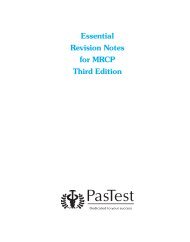SURGICAL FINALS Passing the Clinical - PasTest
SURGICAL FINALS Passing the Clinical - PasTest
SURGICAL FINALS Passing the Clinical - PasTest
- No tags were found...
Create successful ePaper yourself
Turn your PDF publications into a flip-book with our unique Google optimized e-Paper software.
S E C T I O N 11. InpatientsMost inpatients transferred to <strong>the</strong> examination will be awaitingoperations such as hernia repairs or removal of breast lumps.Postoperative patients are also available for <strong>the</strong> clinicals: after all, you willbe expected to manage such patients in your F1 and F2 years. A minorityof patients will be those recovering from acute conditions, with goodhistories and/or physical signs that have not yet resolved.2. Patients coming up from clinicsPatients with good physical signs who attend clinics in <strong>the</strong> few weeksbefore <strong>the</strong> clinicals are often asked to come up for <strong>the</strong> examination. Try toattend clinics in your hospital in <strong>the</strong> lead-up to finals. (For example, beforesurgical finals, one of <strong>the</strong> authors walked into <strong>the</strong> examination centre witha fellow candidate who pointed out two patients who she recognised:‘He has a sebaceous cyst on his forehead. She’s got a left submandibulartumour.’ After revising <strong>the</strong>se two conditions, she was given both patientsas short cases!)3. ‘Professional’ patientsThese are patients with long-standing signs who are listed on a computerdatabase and who have been called up numerous times in <strong>the</strong> past. Suchpatients are usually excellent historians and may even point out <strong>the</strong>irphysical signs.4. Simulated patientsSimulated patients are healthy individuals who are trained to simulatea patient’s illness in a standard manner. They are usually actors. Sometraining is usually required to ensure that <strong>the</strong>y are able to bring out<strong>the</strong> main points in <strong>the</strong> history on request and within <strong>the</strong> time allowed.Simulated patients can become skilled historians and very persuasivepatients, such as when replicating a psychiatric disturbance. They areoften asked to give <strong>the</strong>ir own marks on <strong>the</strong> student encounter.In addition a video of a patient presenting a history can be shown.4
















